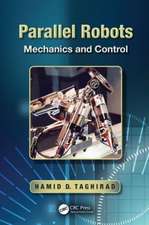Advances in Physarum Machines: Sensing and Computing with Slime Mould: Emergence, Complexity and Computation, cartea 21
Editat de Andrew Adamatzkyen Limba Engleză Hardback – 18 ian 2016
The book is a treatise of theoretical and experimental laboratory studies on sensing and computing properties of slime mould, and on the development of mathematical and logical theories of Physarum behavior.
It is shown how to make logical gates and circuits, electronic devices (memristors, diodes, transistors, wires, chemical and tactile sensors) with the slime mould. The book demonstrates how to modify properties of Physarum computing circuits with functional nano-particles and polymers, to interface the slime mould with field-programmable arrays, and touse Physarum as a controller of microbial fuel cells.
A unique multi-agent model of slime is shown to serve well as a software slime mould capable for solving problems of computational geometry and graph optimization. The multiagent model is complemented by cellular automata models with parallel accelerations. Presented mathematical models inspired by Physarum include non-quantum implementation of Shor's factorization, structural learning, computation of shortest path tree on dynamic graphs, supply chain network design, p-adic computing and syllogistic reasoning.
The book is a unique composition of vibrant and lavishly illustrated essays which will inspire scientists, engineers and artists to exploit natural phenomena in designs of future and emergent computing and sensing devices. It is a 'bible' of experimental computing with spatially extended living substrates, it spanstopics from biology of slime mould, to bio-sensing, to unconventional computing devices and robotics, non-classical logics and music and arts.
| Toate formatele și edițiile | Preț | Express |
|---|---|---|
| Paperback (1) | 1406.35 lei 6-8 săpt. | |
| Springer International Publishing – 30 mar 2018 | 1406.35 lei 6-8 săpt. | |
| Hardback (1) | 1415.22 lei 6-8 săpt. | |
| Springer International Publishing – 18 ian 2016 | 1415.22 lei 6-8 săpt. |
Din seria Emergence, Complexity and Computation
- 8%
 Preț: 397.83 lei
Preț: 397.83 lei - 18%
 Preț: 1132.65 lei
Preț: 1132.65 lei - 18%
 Preț: 946.72 lei
Preț: 946.72 lei - 20%
 Preț: 651.75 lei
Preț: 651.75 lei - 20%
 Preț: 570.97 lei
Preț: 570.97 lei - 15%
 Preț: 653.33 lei
Preț: 653.33 lei - 15%
 Preț: 648.24 lei
Preț: 648.24 lei - 15%
 Preț: 651.19 lei
Preț: 651.19 lei - 20%
 Preț: 940.98 lei
Preț: 940.98 lei -
 Preț: 392.37 lei
Preț: 392.37 lei - 15%
 Preț: 647.59 lei
Preț: 647.59 lei - 15%
 Preț: 641.71 lei
Preț: 641.71 lei - 15%
 Preț: 645.28 lei
Preț: 645.28 lei - 15%
 Preț: 649.06 lei
Preț: 649.06 lei - 20%
 Preț: 1304.44 lei
Preț: 1304.44 lei - 20%
 Preț: 1296.18 lei
Preț: 1296.18 lei - 20%
 Preț: 655.35 lei
Preț: 655.35 lei - 15%
 Preț: 648.56 lei
Preț: 648.56 lei - 18%
 Preț: 953.82 lei
Preț: 953.82 lei - 20%
 Preț: 657.02 lei
Preț: 657.02 lei - 18%
 Preț: 1117.03 lei
Preț: 1117.03 lei - 20%
 Preț: 992.26 lei
Preț: 992.26 lei - 15%
 Preț: 656.74 lei
Preț: 656.74 lei - 20%
 Preț: 649.60 lei
Preț: 649.60 lei - 15%
 Preț: 654.43 lei
Preț: 654.43 lei - 20%
 Preț: 661.14 lei
Preț: 661.14 lei - 20%
 Preț: 645.47 lei
Preț: 645.47 lei - 20%
 Preț: 658.19 lei
Preț: 658.19 lei - 20%
 Preț: 644.15 lei
Preț: 644.15 lei - 18%
 Preț: 880.77 lei
Preț: 880.77 lei - 20%
 Preț: 1455.75 lei
Preț: 1455.75 lei - 20%
 Preț: 1158.26 lei
Preț: 1158.26 lei
Preț: 1415.22 lei
Preț vechi: 1725.87 lei
-18% Nou
Puncte Express: 2123
Preț estimativ în valută:
270.81€ • 289.58$ • 225.79£
270.81€ • 289.58$ • 225.79£
Carte tipărită la comandă
Livrare economică 17 aprilie-01 mai
Preluare comenzi: 021 569.72.76
Specificații
ISBN-13: 9783319266619
ISBN-10: 3319266616
Pagini: 870
Ilustrații: X, 839 p. 454 illus., 131 illus. in color.
Dimensiuni: 155 x 235 x 44 mm
Greutate: 1.43 kg
Ediția:1st ed. 2016
Editura: Springer International Publishing
Colecția Springer
Seria Emergence, Complexity and Computation
Locul publicării:Cham, Switzerland
ISBN-10: 3319266616
Pagini: 870
Ilustrații: X, 839 p. 454 illus., 131 illus. in color.
Dimensiuni: 155 x 235 x 44 mm
Greutate: 1.43 kg
Ediția:1st ed. 2016
Editura: Springer International Publishing
Colecția Springer
Seria Emergence, Complexity and Computation
Locul publicării:Cham, Switzerland
Public țintă
ResearchCuprins
Part I Experimental.- Part II Theoretical.- Part III Music and Art.
Recenzii
“This very, very extensive volume (of over 800 pages) is an excellent introduction to the area, but it is also particularly useful to those both new to the system as well as experienced researchers who wish to understand practical and low-level details from one integrated source rather than searching through many research articles and technical reports.” (Sara Kalvala, Computing Reviews, computingreviews.com, June, 2016)
Textul de pe ultima copertă
This book is devoted to Slime mould Physarum polycephalum, which is a large single cell capable for distributed sensing, concurrent information processing, parallel computation and decentralized actuation. The ease of culturing and experimenting with Physarum makes this slime mould an ideal substrate for real-world implementations of unconventional sensing and computing devices
The book is a treatise of theoretical and experimental laboratory studies on sensing and computing properties of slime mould, and on the development of mathematical and logical theories of Physarum behavior.
It is shown how to make logical gates and circuits, electronic devices (memristors, diodes, transistors, wires, chemical and tactile sensors) with the slime mould. The book demonstrates how to modify properties of Physarum computing circuits with functional nano-particles and polymers, to interface the slime mould with field-programmable arrays, and touse Physarum as a controller of microbial fuel cells.
A unique multi-agent model of slime is shown to serve well as a software slime mould capable for solving problems of computational geometry and graph optimization. The multiagent model is complemented by cellular automata models with parallel accelerations. Presented mathematical models inspired by Physarum include non-quantum implementation of Shor's factorization, structural learning, computation of shortest path tree on dynamic graphs, supply chain network design, p-adic computing and syllogistic reasoning.
The book is a unique composition of vibrant and lavishly illustrated essays which will inspire scientists, engineers and artists to exploit natural phenomena in designs of future and emergent computing and sensing devices. It is a 'bible' of experimental computing with spatially extended living substrates, it spanstopics from biology of slime mould, to bio-sensing, to unconventional computing devices androbotics, non-classical logics and music and arts.
The book is a treatise of theoretical and experimental laboratory studies on sensing and computing properties of slime mould, and on the development of mathematical and logical theories of Physarum behavior.
It is shown how to make logical gates and circuits, electronic devices (memristors, diodes, transistors, wires, chemical and tactile sensors) with the slime mould. The book demonstrates how to modify properties of Physarum computing circuits with functional nano-particles and polymers, to interface the slime mould with field-programmable arrays, and touse Physarum as a controller of microbial fuel cells.
A unique multi-agent model of slime is shown to serve well as a software slime mould capable for solving problems of computational geometry and graph optimization. The multiagent model is complemented by cellular automata models with parallel accelerations. Presented mathematical models inspired by Physarum include non-quantum implementation of Shor's factorization, structural learning, computation of shortest path tree on dynamic graphs, supply chain network design, p-adic computing and syllogistic reasoning.
The book is a unique composition of vibrant and lavishly illustrated essays which will inspire scientists, engineers and artists to exploit natural phenomena in designs of future and emergent computing and sensing devices. It is a 'bible' of experimental computing with spatially extended living substrates, it spanstopics from biology of slime mould, to bio-sensing, to unconventional computing devices androbotics, non-classical logics and music and arts.
Caracteristici
A 'bible' of experimental computing with spatially extended living substrates Presents topics of complex systems, emergence, self-organization, mathematical machines in any easily understandable way With contributions from world top experts in applied and computer science, biology, logics and philosophy, nanotechnology Lavishly illustrated With visually attractive examples of slime mould based computing devices Includes supplementary material: sn.pub/extras























